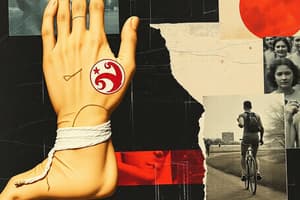Podcast
Questions and Answers
Which of the following soft tissue lesions involves bleeding into a joint?
Which of the following soft tissue lesions involves bleeding into a joint?
- Hemarthrosis (correct)
- Synovitis
- Bursitis
- Tendinopathy
A patient reports moderate swelling, bruising, and significant pain accompanied by loss of range of motion (ROM) following an ankle injury. Which grade of sprain is MOST likely?
A patient reports moderate swelling, bruising, and significant pain accompanied by loss of range of motion (ROM) following an ankle injury. Which grade of sprain is MOST likely?
- Subluxation
- Grade 1
- Grade 2 (correct)
- Grade 3
According to the 'Healing Times by Grade' chart, which injury is expected to have the LONGEST healing time?
According to the 'Healing Times by Grade' chart, which injury is expected to have the LONGEST healing time?
- Tendonitis
- Grade 3 Ligament Sprain (correct)
- Grade 1 Muscle Strain
- Fracture
During which phase of soft tissue repair does collagen align to stress?
During which phase of soft tissue repair does collagen align to stress?
What is the PRIMARY goal of the inflammatory phase in soft tissue healing?
What is the PRIMARY goal of the inflammatory phase in soft tissue healing?
According to the PEACE acronym, which of the following is MOST appropriate immediately after a soft tissue injury?
According to the PEACE acronym, which of the following is MOST appropriate immediately after a soft tissue injury?
In which phase of soft tissue healing is pain synchronous with tissue resistance typically observed?
In which phase of soft tissue healing is pain synchronous with tissue resistance typically observed?
Which of the following is MOST emphasized during the remodeling phase of soft tissue healing?
Which of the following is MOST emphasized during the remodeling phase of soft tissue healing?
Which of the following factors is MOST likely to impede soft tissue healing?
Which of the following factors is MOST likely to impede soft tissue healing?
A 23-year-old strained his back two weeks ago. He reports pain at end-range flexion and rotation. Which phase of healing is he MOST likely in?
A 23-year-old strained his back two weeks ago. He reports pain at end-range flexion and rotation. Which phase of healing is he MOST likely in?
Flashcards
What is a Strain?
What is a Strain?
Injury to the musculotendinous unit.
What is a Sprain?
What is a Sprain?
Injury to a joint capsule or ligament.
What is a Dislocation?
What is a Dislocation?
Complete displacement of a joint.
What is a Subluxation?
What is a Subluxation?
Signup and view all the flashcards
What is Tendinopathy?
What is Tendinopathy?
Signup and view all the flashcards
What is Synovitis?
What is Synovitis?
Signup and view all the flashcards
What is Hemarthrosis?
What is Hemarthrosis?
Signup and view all the flashcards
What is Bursitis?
What is Bursitis?
Signup and view all the flashcards
What is a Contusion?
What is a Contusion?
Signup and view all the flashcards
What does PEACE stand dor?
What does PEACE stand dor?
Signup and view all the flashcards
Study Notes
Objectives of Soft Tissue Healing Understanding
- Understand various soft tissue lesions and their definitions
- Learn the phases of soft tissue healing.
- Know general treatment recommendations for each phase of healing
- Understand the use of the acronyms PEACE and LOVE in soft tissue injury management
Types of Soft Tissue Lesions
- Strain involves the musculotendinous unit
- Sprain affects the joint capsule and ligaments
- Dislocation refers to a complete displacement
- Subluxation is a partial displacement
- Tendinopathy is a tendon pathology due to mechanical load
- Synovitis involves inflammation of the synovial membrane
- Hemarthrosis refers to bleeding within a joint
- Bursitis is inflammation of a bursa
- Contusion refers to bruising resulting from trauma
Grades of Sprain/Strain Injuries:
- Grade 1 involves stretching or microscopic tears, minimal swelling, localized pain, and almost normal ROM.
- Grade 2 involves a partial tissue tear, moderate swelling and bruising, and loss of ROM with significant pain.
- Grade 3 is a complete tear with severe pain, swelling, bruising, and loss of ROM.
Soft Tissue Repair Phases:
- Inflammatory Phase involves damage assessment and clearing out damaged tissue and lasts 4-6 days up to 2 weeks.
- Proliferative Phase involves the start of repairs for 4-24 days, or up to 6 weeks in limited circulation areas like tendons.
- Remodeling Phase is for strengthening and completing repairs within 3 weeks to 2 years, depending on tissue and damage grade.
Characteristics and Management of the Inflammatory Phase:
- Tissue response involves chemical signals like histamine and bradykinin that cause vascular changes and edema.
- Chemotaxis attracts leukocytes and immune cells to the area, leading to clot formation and phagocytosis.
- Clinical signs include redness, swelling, heat, and pain, with movement causing pain before tissue resistance.
- Management focuses on controlling stress in the injured tissue through protection, reducing swelling, not interfering with the inflammatory response, and using pain as a guide.
- Implement PEACE: Protection, Elevation, Avoid anti-inflammatories, Compression, Education
Characteristics and Management of the Proliferative Phase:
- Tissue response involves growth of capillary beds, collagen formation (Type III), and granulation tissue.
- Clinical signs include pain synchronous with tissue resistance and decreasing inflammation.
- Management involves continued controlled stressing of tissues, progressing ROM, intensity, and frequency, with a focus on restrictions
- Still fragile tissue requires no quick, explosive movements, and monitor pain levels.
- Implement LOVE: Load, Optimism, Vascularization, Exercise
Characteristics and Management of the Remodeling Phase:
- Tissue response involves maturation of scar tissue, contracture of scar tissue, remodeling of Type III collagen to Type I, and collagen aligning to stress.
- Clinical signs include no inflammation signs, and movement causes pain at end-range tissue resistance.
- Management involves progressive stress to tissues by increasing volume, load, and intensity
- Incorporate rapid, quick, power movements, progressive return to prior levels, and avoiding pain while accepting discomfort when pushing limits.
Factors Affecting Healing:
- Lifestyle factors include diet, activity levels, smoking/alcohol, and stress.
- Comorbidities include age, obesity, diabetes, and immunocompromised conditions.
Application to Cases:
- Identify the phase of healing
- Determine when the patient will move to the next phase
- Provide education appropriate for the healing phase
- Determine an appropriate intervention for the patient
Case Examples
- The cases below are for educational use to identify the phase, what phase is next, patient education and interventions
Case 1
- A 16-year-old with a Grade 1 ATFL sprain 36 hours ago has slight swelling, 4/10 pain, pain at end-range dorsiflexion and inversion.
- No pain with ambulation, but pain with running, jumping, and cutting, is wanting to be ready for a game tomorrow night
Case 2
- A 40-year-old with a Grade 2 hamstring strain for 2 months, no swelling, no pain with daily activities, some discomfort with stairs and running (2/10), slight pain (2/10) at end-range stretch.
- Wants to be ready for softball season in a couple of months.
Case 3
- A 23-year-old strained his back 2 weeks ago, slowly regaining ROM with pain (4/10) at end-range flexion and rotation, no pain at rest except sitting for more than 30 minutes (4/10).
- Wants to be able to get back to running and be ready for a plane ride to Germany in 1 month.
Studying That Suits You
Use AI to generate personalized quizzes and flashcards to suit your learning preferences.




